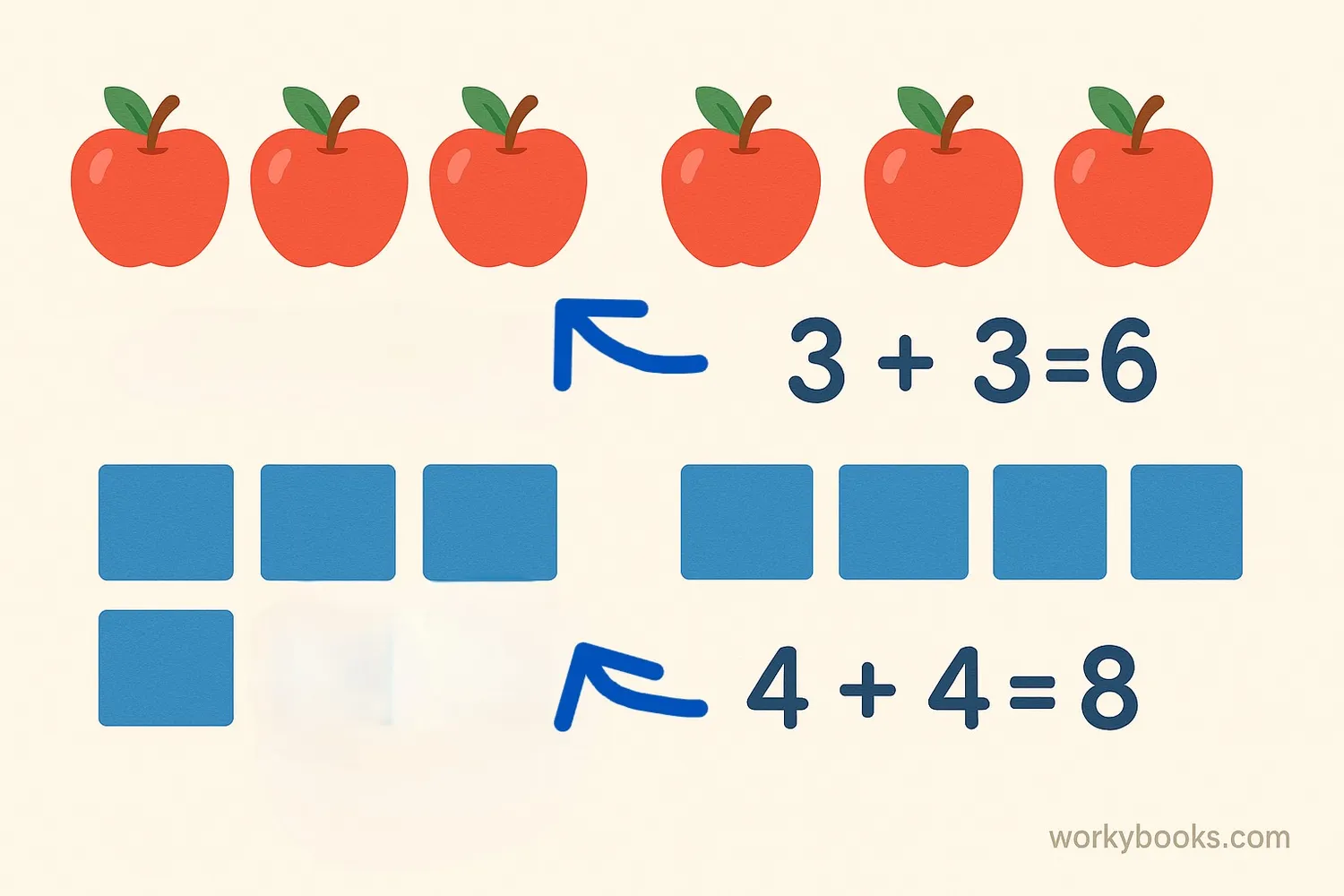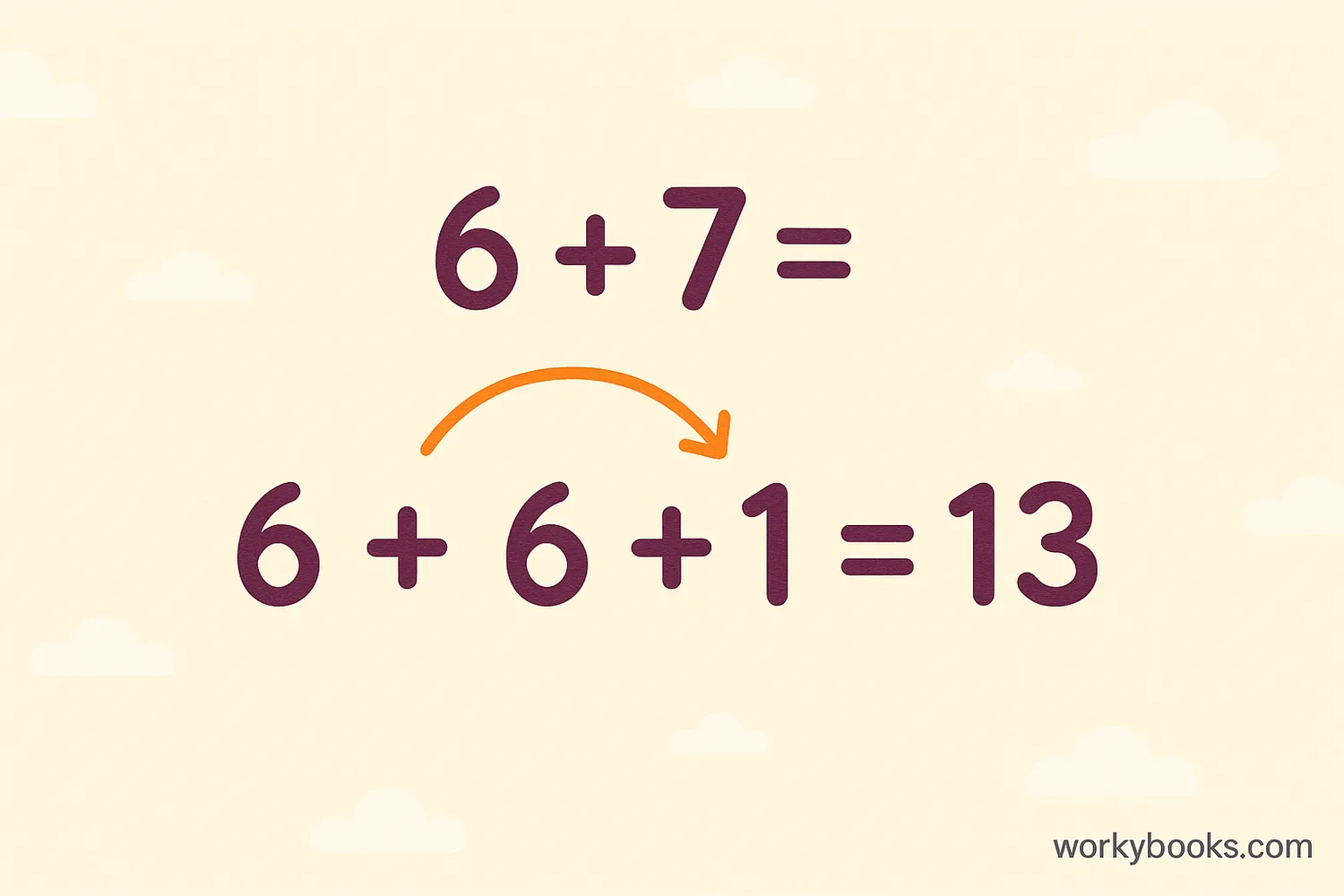Doubles - Definition, Examples, Quiz, FAQ, Trivia
Master addition strategies with doubles facts, doubles plus one, and doubles minus one techniques
What are Doubles?

Doubles in math are when we add a number to itself. This is one of the easiest addition facts to learn because the two numbers being added are the same!
Think of things that come in pairs - like eyes, ears, or hands. When you have two of the same thing, you're seeing doubles in real life.
Examples of doubles:
1 + 1 = 2
2 + 2 = 4
3 + 3 = 6
4 + 4 = 8
5 + 5 = 10
Why are doubles important?
Learning doubles helps you solve addition problems faster. Once you know your doubles facts, you can use them to solve other math problems more easily!
Doubles Facts
Doubles facts are the basic addition facts where a number is added to itself. Here are all the doubles facts you should know:
| Addition Problem | Answer | Visual Representation |
|---|---|---|
| 1 + 1 | 2 | ●● |
| 2 + 2 | 4 | ●● ●● |
| 3 + 3 | 6 | ●●● ●●● |
| 4 + 4 | 8 | ●●●● ●●●● |
| 5 + 5 | 10 | ●●●●● ●●●●● |
| 6 + 6 | 12 | ●●●●●● ●●●●●● |
| 7 + 7 | 14 | ●●●●●●● ●●●●●●● |
| 8 + 8 | 16 | ●●●●●●●● ●●●●●●●● |
| 9 + 9 | 18 | ●●●●●●●●● ●●●●●●●●● |
| 10 + 10 | 20 | ●●●●●●●●●● ●●●●●●●●●● |
Pattern Tip
Notice how doubles facts always make even numbers? This pattern can help you remember them!
Doubles Plus One Strategy
The doubles plus one strategy helps you add numbers that are consecutive (next to each other in counting). When you see a problem like 4 + 5, you can think:
1. What's the smaller number? (4)
2. Double it: 4 + 4 = 8
3. Add one more: 8 + 1 = 9
So 4 + 5 = 9!
Doubles Plus One Formula
Where n is the smaller number
Practice Examples
5 + 6 = ?
Think: 5 + 5 = 10, then 10 + 1 = 11
So 5 + 6 = 11
7 + 8 = ?
Think: 7 + 7 = 14, then 14 + 1 = 15
So 7 + 8 = 15
Doubles Minus One Strategy
The doubles minus one strategy is similar to doubles plus one, but we subtract instead. When you see a problem like 5 + 4, you can think:
1. What's the larger number? (5)
2. Double it: 5 + 5 = 10
3. Subtract one: 10 - 1 = 9
So 5 + 4 = 9!
Doubles Minus One Formula
Where n is the larger number
Practice Examples
6 + 5 = ?
Think: 6 + 6 = 12, then 12 - 1 = 11
So 6 + 5 = 11
8 + 7 = ?
Think: 8 + 8 = 16, then 16 - 1 = 15
So 8 + 7 = 15
Using Doubles Addition Strategy

Once you know your doubles facts, you can use them to solve many other addition problems quickly. This is called the doubles strategy.
How to use the doubles strategy:
1. Look at the numbers in the problem
2. Check if they're close to a doubles fact
3. Adjust the doubles fact by adding or subtracting the difference
Strategy Examples
Example 1: 4 + 6
Think: 5 + 5 = 10, but 4 is one less than 5 and 6 is one more than 5
So 4 + 6 = (5 + 5) - 1 + 1 = 10
Example 2: 7 + 9
Think: 8 + 8 = 16, but 7 is one less than 8 and 9 is one more than 8
So 7 + 9 = (8 + 8) - 1 + 1 = 16
Doubles Practice Quiz
Test your understanding of doubles with this 5-question quiz. Choose the correct answer for each question.
Frequently Asked Questions
Here are answers to common questions about doubles in math:
Math Trivia
Discover interesting facts about math and numbers:
Ancient Doubles
The concept of doubling dates back to ancient Egypt, where mathematicians used a method called "duplation" for multiplication that involved repeatedly doubling numbers.
Doubles in Nature
Many things in nature come in doubles - animals have two eyes, two ears, and two sides to their body. Even leaves often grow in pairs on stems!
Doubles Record
The largest number of times a number has been doubled and verified is 2^82,589,933 - 1, a number with 24,862,048 digits!
Doubles in Games
In many board games like backgammon and Monopoly, rolling doubles gives you special advantages, like an extra turn!


